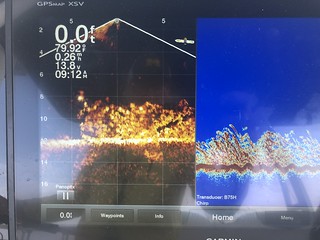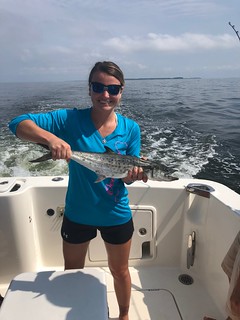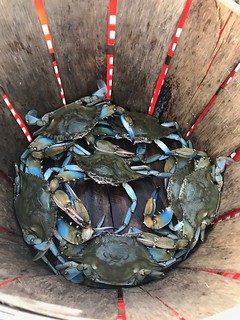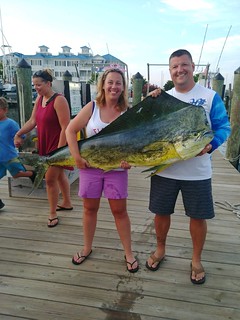Maryland Fishing Report – Aug. 21

Memories are made while fishing and crabbing and this guy is lucky enough to have a grandfather to take him crabbing. Photo by Jim Livingston
We are on the back end of August and there are signs everywhere that the summer season is coming to a close — but there’s still time for families to spend some quality time together fishing.
Looking ahead, Maryland anglers will be able to offer their input to the Atlantic States Marine Fisheries Commission on proposed striped bass regulations for 2020. Fishermen and other stakeholders are encouraged to provide input on a draft amendment either by attending a public meeting September 25 in Annapolis or providing written comment by 5 p.m. Oct. 7. More info can be found online.
The Maryland public hearing will be held 6 p.m. to 8 p.m. Sept. 25 at Calvary United Methodist Church (Basement Room), 301 Rowe Blvd., Annapolis.
Comments should be sent by mail too Max Appelman, Fishery Management Plan Coordinator, 1050 N. Highland St, Suite A-N, Arlington, VA 22201; by Fax to 703-842-0741, or by email to comments@asmfc.org (Subject line: Striped Bass Draft Addendum VI).
Forecast Summary: Aug. 21-27
Even though we are losing about 14 minutes of daylight every week, the sun’s rays are still hot enough to keep local waters warm. That said, this week we will slightly cooler temperatures beginning on Friday. The same general fishing pattern will continue. Focus on areas with adequate oxygen and the coolest water just above the “Do not fish below this depth” mark. Most of these deeper, cool main Bay areas with adequate oxygen are registering a warm 81 degrees. The other way to find cooler water is to fish the shallows near prime day-time areas at first light or after sunset when surface water temperatures can be several degrees cooler.
Bay surface salinities are still below normal for this time of year but improving slightly. In most shallower Bay waters, anglers will find adequate oxygen for gamefish from the surface down to about 20 feet. Notable exceptions are rivers including the Patapsco (16 feet), Magothy (13 feet), Severn (13 feet), West (7 feet), South (7 feet) and Patuxent River below Benedict (10 feet). However, to avoid low oxygen conditions in the deep channel waters from the Bay Bridge down to the state line and the lower Potomac River, avoid fishing deeper than 26 feet. At the Bay Bridge, avoid fishing below 15 feet. In these areas, windy conditions may force low oxygen water into very shallow waters. For oxygen forecasts, see VIMS Depth to 3 mg/l .
Expect poor water clarity from algal blooms from the Patapsco River down to the Chester River and the mouth of the Potomac River plus the area from the Colonial Beach to St. Mary’s.
Water temperatures are in the low to middle 80s throughout the Bay and in the Choptank and lower Potomac rivers. Water temperatures at Little Falls have risen to the mid 80s. For more details, check the online “Water Temperature by Depth” map. Expect normal flows from most of Maryland’s rivers and streams this week. There will be above average tidal currents Wednesday and Tuesday next week as a result of the upcoming new moon Aug. 30.
For the full weekly fishing conditions summary and more detailed and up-to-date fishing conditions in your area of the bay, be sure to check out Click Before You Cast. You can now get regular updates on Maryland’s waters and the creatures that call them home sent to your inbox with our new Eyes on the Bay newsletter. Sign up online.
Striped Bass Summer Fishing Advisory Forecast:

Red: Air temperatures are forecast at 95 degrees or higher. Anglers are encouraged not to fish for striped bass after 10 a.m. and should target other species of fish.
Yellow: Air temperatures are forecast at 90-94 degrees. Anglers should use extreme care when fishing for striped bass; fish should be kept in the water when caught and released on these days.
Green: Fishing conditions are normal. Proper catch-and-release practices are encouraged.
More information about this awareness campaign can be found on the Striped Bass Fishing Advisory Forecast webpage.
When it comes to fishing for striped bass here, the old saying that the early bird gets the worm comes to mind. You stand a better chance of catching legal-sized striped bass if you can get to them before the sun breaks the horizon. The Bay Bridge piers, Love Point rocks, Swan Point, and the Triple Buoys area are all holding striped bass. Once the sun comes up most of the action tends to be catching striped bass less than 20 inches, and this group of fish is not doing well with catch-and-release in this extreme heat. Anyone motoring the bay near a tide line will be taken back by the numbers of dead striped bass in the water. Anglers are reminded that they must use circle hooks when live-lining. Check our website and video for more information on circle hooks and careful release.
Live-lining spot or white perch continues to be the most popular way to fish for striped bass this week and most will agree that a good running tide is very important. The striped bass are holding in less than 20 feet of water at the above traditional locations and others such as the Key Bridge piers and Pooles Island. There is also some topwater action at dawn at the Conowingo Dam pool and the lower Susquehanna River. Most anglers are casting a variety of topwater lures, crankbaits or jigs.

Photo of by Keith Lockwood
Jigging around the Bay Bridge piers or the rips at Love Point continue to be a viable option this week. Soft plastic jigs in ½-ounce to 1 ounce sizes are used depending on water depth and the strength of the tide. Skirted jigs are an asset and 6-inch plastic bodies in pearl, white or with a little chartreuse blended in work well. Squeezing a little menhaden paste in the slot that most soft plastic bodies have is always a good idea, and some like dipping the tail end in red garlic scent. The most important tactic at the bridge piers is to get in tight, cast up-current and work the jig with the current. Bouncing off concrete is part of the game. The bridge piers from 10 feet to 20 feet are all fair game, and the piers on the westbound span definitely offer more structure. At Love Point work your jig in a sweeping arch with the current, slightly bouncing along the bottom, pickup is usually at the apex of the arch.
Breaking fish and diving seagulls are being seen in the upper bay this week, closer inspection usually reveals 8-inch to 12-inch striped bass chasing bay anchovies. There are also plenty of menhaden in the 6-inch to 12-inch size range moving about in the upper bay relatively unmolested.
Fishing for white perch has been very good in a variety of locations in the upper bay and nearby tidal rivers. Those include shoal areas near Swan Point, 7 and 9 Foot Knolls, the mouth of the Magothy River, the Chester River and the west side of the Bay Bridge. In all of these areas, the depths are less than 20 feet and bottom rigs baited with pieces of bloodworm is standard fare. Spot are being found on the shallower end of the western side of the Bay Bridge, in front of Sandy Point State Park, and the mouth of the Magothy River.
Most of the live lining for striped bass in the middle bay region is taking place at Thomas Point Light, and unfortunately a very high percentage of the fish being caught are sub-legal. There has been some action at Bloody Point and the Hill and of course anywhere striped bass can be found suspended near channel edges at depths less than 20’. Spot can be found in many of the shallower areas in the bay and tidal rivers by bottom fishing with pieces of bloodworm.
Perhaps the best news in the middle bay region is the schools of Spanish mackerel that are everywhere chasing bay anchovies. The most fun way to catch them is to cast small heavy metal lures, let them sink a bit and then reel as fast as you can. The other way to catch them is to troll small Drone and Clark spoons behind inline weights and #1 planers. Use long leaders of approximately 12 feet to 15 feet of wire or mono and spoons in gold or silver. Many are finding that using Drone spoons with chartreuse highlights on them have worked well also. The edges of the shipping channel and other areas of swift current that funnel baitfish are good places to look for them. Trolling speeds are faster than what you would do for striped bass.

This depth finder image shows a large school of white perch just waiting for someone to drop a baited bottom rig to them. Photo by Bob Bruns
Fishing for white perch is providing plenty of fun fishing for a wide range of fishing abilities from the most ardent fishermen to families and our youngest anglers. White perch are holding near docks and shoreline structure in the many creeks and tidal waters of the middle bay region.
Fishing a simple bottom rig baited with pieces of bloodworm or grass shrimp near docks and bottom structure. Casting beetle spins, spinners and small spinnerbaits are all great lures to cast near shoreline structure in the morning and evening hours. Fallen treetops, docks and shoreline rip rap are great places to find white perch when casting lures. They can be found out in the bay also often on the same shallow areas where spot are being found.

Photo courtesy of Courtney Guido
The lower bay region is presenting a wide variety of fishing opportunities. Spanish mackerel are at the top of the list for fun and excellent eating. Just remember to not get too carried away with your good fortune. They are best eaten fresh and do not freeze well. Trolling a mix of gold or silver Drone or Clark spoons with long leaders behind inline weights and or planers is the ticket to the show.
Shipping channel edges are a good place to start where they are on the prowl for bait being swept along by swift currents. Trolling on the outside edges of surface activity is also a good choice as long as you do not run through breaking fish or disturb those casting to them. Casting small metal lures to breaking fish is great light tackle fun. Allow the lure to sink to a 5 count or so and then reel as fast as you can.
There are some bluefish mixed in with the Spanish mackerel and once and a while large red drum can be spotted on depth finders close to the bottom under the breaking fish. Bluefish can be caught by trolling spoons or red and green hoses, casting lures or chumming.
A few cobia are being caught between the Middle Grounds and the Target Ship. Most are sight fishing and casting live eels to fish when they are spotted. We’re seeing some pretty inventive ways to get up higher on center console boats such as ladders and deer hunting ladder stands lashed to boats, be careful out there. Unfortunately many of the cobia being caught are falling slightly under the 40-inch minimum.
There continues to be fair to good live lining action for striped bass at the steep channel edge in the lower Potomac between St. Georges Island and Piney Point. There are a lot of sub-legal fish being caught so be careful when releasing them and be quick about it. Water temperatures are extremely warm causing significant stress to released fish.
Bottom fishing for spot continues to be excellent in the lower Potomac and Patuxent rivers as well as Tangier Sound. There are a lot of small spot but most are able to catch plenty of larger eating size spot. A mix of white perch, small croaker and bluefish can be part of the mix. Now and then small weakfish, speckled trout and kingfish can add a little spice to catches. Over at the Tangier Sound and Pocomoke Sound area flounder are being caught along channel edges and speckled trout near the marsh edges and creeks.

Photo by Jim Livingston
Most recreational crabbers are reporting that the largest crabs are being caught in water depths of 10 feet or better. They are also reporting that crabs can be felt dropping off trotlines as they approach the surface, making collapsible crab traps a viable option. Razor clams and chicken necks are the two most common baits being used. The shallows are reported to be holding a lot of small crabs. A significant portion of the legal crabs being caught can be light so check out your catch and toss them back so they can fill out with more meat.
Shedding continues and this may be the last big shed of the season; doublers can be seen swimming or holding on to dock piers and a lot of sponge crabs are swimming south in the lower bay region. The best crabbing success has been in the lower and middle bay regions.
The summer heat continues but as September approaches there may be light at the end of the tunnel. Put and take trout fishermen will be looking forward to the fall trout stocking program that takes place in October, often close to home. In the meantime those wishing for a little trout fishing can find it at some of the trout management waters that are restricted to fly fishing and are catch and release. The upper Gunpowder River is perhaps one of the better places to fish close to Baltimore. The western region of Maryland has many trout management waters and some ideal fishing in the catch and release areas. You can find more information about our various trout management waters online.

Photo by Erick Packard
Largemouth bass are feeling the heat just like fishermen are this week. They are mostly feeding at night in the shallower areas that contain grass small baitfish use to hide. It is best to get out on the water at dawn and target those shallow and grassy areas with buzzbaits, spinnerbaits, lipless crankbaits and soft plastics. As the morning wears on try fishing through thick grass that is in deeper water where bass will be lounging underneath in cooler shade. Northern snakeheads will also be found lurking in the thick grassy areas. Weighted stick worms and soft plastics dropped through the grass can entice a pick up. The shade of docks, fallen treetops and bridge piers are also good places to target. Small feeder creeks that have cooler water flows can also be a good place to look. In the late evenings as things cool down, largemouth bass can be intercepted as they approach the shallower feeding areas.
Fishing for bluegills and other sunfish species is very good at this time of the year, and mornings and evenings offer the best fishing. Fishing for catfish species can be a fun diversion, especially if fishing from shore with a comfortable chair, shade and good company. Channel catfish can be found in most every tidal river, blue catfish are thick in the lower Potomac, Patuxent, Susquehanna and Nanticoke rivers.
Along the beaches of Ocean City and Assateague Island, surf casters are mostly focusing on small summer species. Kingfish are being caught on pieces of bloodworm along with some spot and croaker. A few are also putting out a line baited with sand fleas in the hope of catching a pompano or perhaps a black drum. Cut spot or mullet is being used to catch bluefish in the surf.
At the inlet and Route 50 Bridge area, there are bluefish moving in and out of the inlet on the tides. Casting metal lures, bucktails, jigs and Got-Cha lures has been the most popular way to catch them. Flounder are of course present in the inlet area and a few sheepshead and triggerfish are being caught at the South Jetty on sand fleas.
Flounder fishing has been good in the back bay channel areas this week. White Gulp baits and live spot or menhaden have been catching the largest flounder. A few striped bass are being caught near the Route 90 and Route 50 bridges.
Outside the inlet perhaps one of the most exciting fishing opportunities are the large numbers of Spanish mackerel being found on the shoal areas. Great Gull, Little Gull and Fenwick shoals have been great places to troll for Spanish mackerel with silver Clark spoons. King mackerel are also part of the mix. Then there are the cobia. Those able to do sight fishing are catching some big cobia by casting live eels to them.
Sea bass fishing has had its daily ups and downs, perhaps mostly based on deep ocean currents bringing in very cold water or warmer water to the wreck sites. Overall most everyone is able to bring some sea bass home. Flounder are becoming a greater part of the mix each week.

Photo by Steve Doctor
For those of us fishing many years, there has been an increasing confusion as to what to call our beloved dolphin. Do we call them dolphinfish, so non-anglers don’t think we’re eating Flipper? How about the Spanish name of dorado?
The most common name that is become more popular is the Hawaiian name of mahi mahi. That’s preferable to the shorthand mahi, which by itself means “farm” in Hawaiian.
Whatever you wish to call these hard-fighting and super eating fish, our state record for dolphinfish has been broken once again. Three weeks ago a 72.8-pound beast of a fish was brought to the Ocean City scales which was a remarkable catch. Last week while fishing in the Poor Girls Tournament out of Ocean City, Kristy Frashure caught a 74.8-pound dolphinfish to set a new state record.
At the canyons, there is a mix of offshore species, water temperatures are warm. White and blue marlin are being caught, a few yellowfin, bigeye tuna as well as wahoo and dolphinfish.
“To the fisherman born, there is nothing so provoking of curiosity as a fishing rod in a case.” — Roland Pertwee
Maryland Fishing Report is written and compiled by Keith Lockwood, Maryland Department of Natural Resources fisheries biologist.
Click Before You Cast is written by Tidewater Ecosystem Assessment Director Tom Parham.
This report is now available on your Amazon Echo device — just ask Alexa to “open Maryland Fishing Report.”

 1-888-373-7888
1-888-373-7888 233733
233733